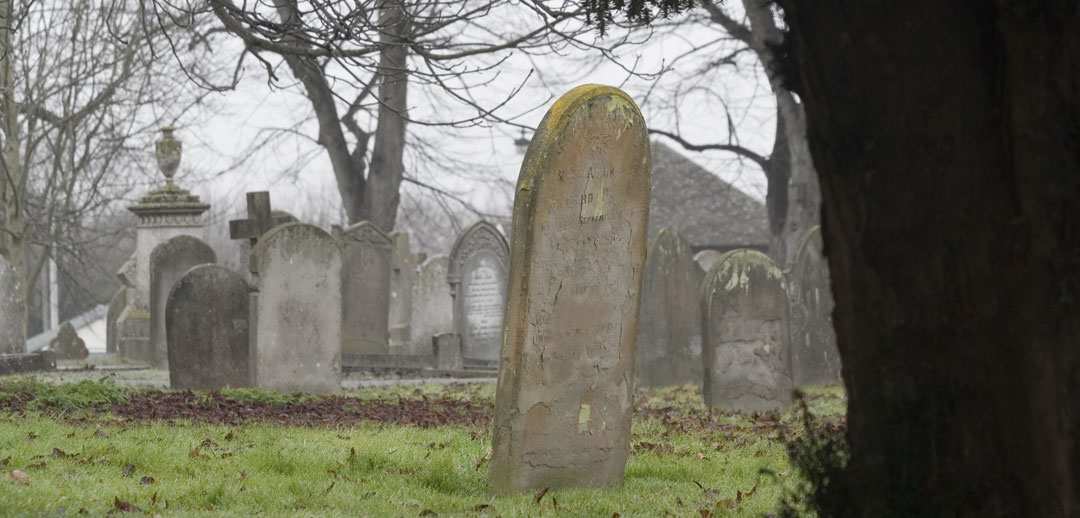In the 1860s and 1870s, life expectancy at birth was 40-45 years. During the Civil War, nearly 750,000 young men died. Death was a constant companion to most people of that era, and an extensive array of customs was developed to deal with it.
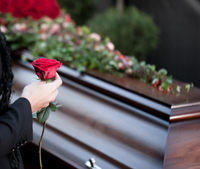 Funerals and Memorial Services
Funerals and Memorial Services
Private funerals during the 1860s and 1870s were often held at home, with the mourners accompanying the hearse to the cemetery. The order of the funeral procession was rigidly prescribed by custom, and the undertaker was responsible for arranging transportation. Friends of the family frequently made the actual funeral arrangements, as the family was expected to remain in seclusion from all society immediately following a death.
Private memorial services did not come into vogue until after the turn of the century, but such services for famous or important public figures were common prior to that. Abraham Lincoln had multiple funerals in the major cities along the route of his funeral train, including New York, Indianapolis and Chicago. In addition, however, memorial services were held throughout the nation, including on April 20, 1865 at San Francisco and on April 19, 1865 at Virginia City, Nevada.
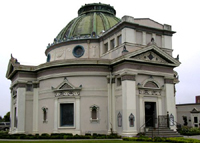 Graveyards and Columbariums
Graveyards and Columbariums
The earliest cemetery in San Francisco was at Mission Dolores; Catholics were buried there and non-Catholics at Telegraph Hill and later at North Beach. In 1850 the first public cemetery, the Yerba Buena Cemetery, was opened. It was a triangular plot bounded by Market, McAllister and Larkin streets, a block east of the present location of the San Francisco City Hall.
In 1870 the Yerba Buena Cemetery was closed and all remains moved to other locations, primarily Lone Mountain Cemetery.
Lone Mountain Cemetery was located between California and Fulton Street and between Divisidero and Arguello; it was in use beginning in 1854. It contained separate sections for various civic organizations, including the Protestant Orphan Asylum, the Typographical Union, several lodges of Odd Fellows, and the Firemen. There was also a separate vault for those Chinese citizens whose remains were held temporarily pending return to China.
In 1862 Lone Mountain Cemetery was divided into Calvary Cemetery, Masonic Cemetery, Odd Fellows Cemetery, and Laurel Hill Cemetery, plus the tiny Greco Russian Cemetery. San Francisco’s Columbarium (repository for human ashes) was built in 1895 and was originally part of the Odd Fellows Cemetery.
City Cemetery, located where the Palace of the Legion of Honor is now, opened in 1868 and contained the city’s potter’s field, among many other sections.
Virginia City had a single cemetery, located at the northern end of town. That cemetery is still in existence today.
PHOTO: By Hugh7 at en.wikipedia [GFDL (www.gnu.org/copyleft/fdl.html), CC-BY-SA-3.0 (http://creativecommons.org/licenses/by-sa/3.0/) or CC-BY-2.5 (http://creativecommons.org/licenses/by/2.5)], from Wikimedia Commons
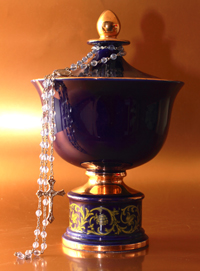 Cremation
Cremation
Cremation had been practiced in some form since earliest times, but fell out of favor by about 400 A.D. For 1500 years, earth burial was nearly universal.
Cremation was formally re-introduced in 1869 in a presentation to the Medical International Congress of Florence by Professors Coletti and Castiglioni. In 1873 Professor Brunetti of Italy perfected a reliable cremation chamber and displayed it at the 1873 Vienna Exposition. The concept rapidly gained adherents, including Sir Henry Thompson, 1st Baronet, a surgeon and Physician to the Queen Victoria.
In 1876 Dr. Julius LeMoyne built the first U.S. crematory in Washington, Pennsylvania. A second followed in 1884 in Lancaster, Pennsylvania, owned and operated by a cremation society.
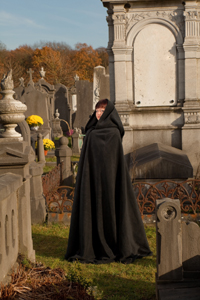 Mourning Practices and Attire
Mourning Practices and Attire
The grieving process was highly stylized throughout the last half of the 19th century, due in part to the influence of Queen Victoria of England. Her consort, Prince Albert, died December 14, 1861 and she remained in mourning until her own death in 1901.
The attire worn, activities undertaken, and time for which mourning was observed following a death in the family were determined by the relationship of the mourner to the decedent.
A widow remained in mourning a total of two years, the first year in ‘deep mourning’, followed by ‘second mourning’ for an additional nine months, then ‘half mourning’ for an additional three to six months.
In ‘deep mourning’ all clothing worn was black; for the first three months the face was to be veiled, and thereafter the veil was worn affixed to the back of the bonnet. All garments were trimmed in crape, and no ornamentation was permitted other than jet. No socialization was permitted for six months, other than church attendance.
In second mourning restrictions were gradually eased. Stark black gave way to gray, mauve, purple, lavender and lilac colors, or subtle patterns using these colors. Limited jewelry was permitted, but only if it was made of, or contained, a lock of the decedent’s hair.
Finally, in half mourning, more color was permitted and jewelry could be worn, but only of certain specified types.
Mourning at the three different levels was observed for various periods of time for other degrees of relationship, such as parent-child, sibling-sibling, and so on.
The unremitting dreariness of mourning clothes did have a lighter side, however. One young widow was chided by her father for purchasing overly expensive mourning clothes. “But Father,” she replied, “It’s cheaper than advertising for a husband.”
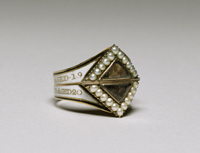 Other Mourning Customs
Other Mourning Customs
Immediately following a death, black crape wreaths were placed on the front door of the house, and the hall door was often left ajar so that mourners could enter without knocking or otherwise making noise. Straw was strewn on the street in front of the house to muffle the sound of horses’ hooves. Mirrors in the household were covered, and clocks stopped at the hour of death.
Stationery and calling cards used during mourning were edged in black.
Jewelry made of or containing the decedent’s hair was frequently worn during mourning, and/or given to the mourners at the funeral. Rings, broaches, bracelets, earrings, necklaces, and watch fobs were all made of this material.
PHOTO: Walters Art Museum [Public domain, CC-BY-SA-3.0 (http://creativecommons.org/licenses/by-sa/3.0 ) or GFDL (http://www.gnu.org/copyleft/fdl.html)], via Wikimedia Commons
 Spiritualism
Spiritualism
Spiritualism began its rise in the late 18th and early 19th century with the teachings of Emanuel Swedenborg (1688–1772) and Franz Mesmer (1734–1815), the father of hypnotism. Both explored the possibilities of an afterlife; Mesmer espoused attempts at contacting the spirits of the dead.
The movement picked up momentum with the emergence of the Fox sisters, Kate and Margaret, in March 1848. Their seances incorporated the iconic ‘spirit rapping’, which gave solid evidence to the senses and appealed to the scientific rationalism of the day.
Initially, seances were genuine attempts to contact the dead. The horrific death toll of the Civil War made grieving widespread, and prominent followers such as Mary Todd Lincoln and Sir Arthur Conan Doyle gave credence to the movement.
Many well-known names in a variety of social and scientific fields explored the practice, including the writer Charles Dickens, the psychologist William James, the prominent speaker and ex-slave Frederick Douglass, and the physicists Pierre and Marie Curie. One of California’s earliest women lawyers, Laura DeForce Gordon, began her public speaking career as a spiritual lecturer. At its height, spiritualism could claim nearly eight million followers in the U.S. and Europe.
However, the movement rapidly came to incorporate showmanship as a significant part of its practice, and it became more a popular entertainment than a serious psychical study. Fraud was repeatedly exposed, particularly by professional magicians such as John Nevil Maskelyne and Harry Houdini. The broader movement largely died out by the 1920s, although spiritualism and the study of parapsychology continue today.
FURTHER READING AND OTHER REFERENCES
Leila’s Hair Museum, dedicated to Victorian hair art, in Independence, MO, http://www.leilashairmuseum.net/
Arlington Cemetary in Drexel Hill, PA, dedicated to the study of beliefs and rituals that surround the arts of dying and grieving. http://arlingtoncemetery.us/museum.asp
Historical Cemeteries of San Francisco, http://www.sfgenealogy.com/sf/history/hcmidx.htm
(Posted October 2014)
